15 SaaS Metrics That Matter Most and How to Use Them
In this article, I'll go through 15 key SaaS metrics every entrepreneur needs to know, including what each one means as well as tips on how you can use it in your own business model!
Sonu kalwar
Share:
There are a lot of metrics you can use to analyze your SaaS marketing performance. Some of them are easy to calculate and get a quick snapshot of how your business is performing, while others require more effort and have to be tracked over time.
In this article, I'll go through 15 key SaaS metrics every entrepreneur needs to know, including what each one means as well as tips on how you can use it in your own business model!
Try Digital First AI's Plug & Play AI-Powered Marketing Workflows Builder

No credit card needed. Instant access. Try now for free.
Monthly Recurring Revenue (MRR)
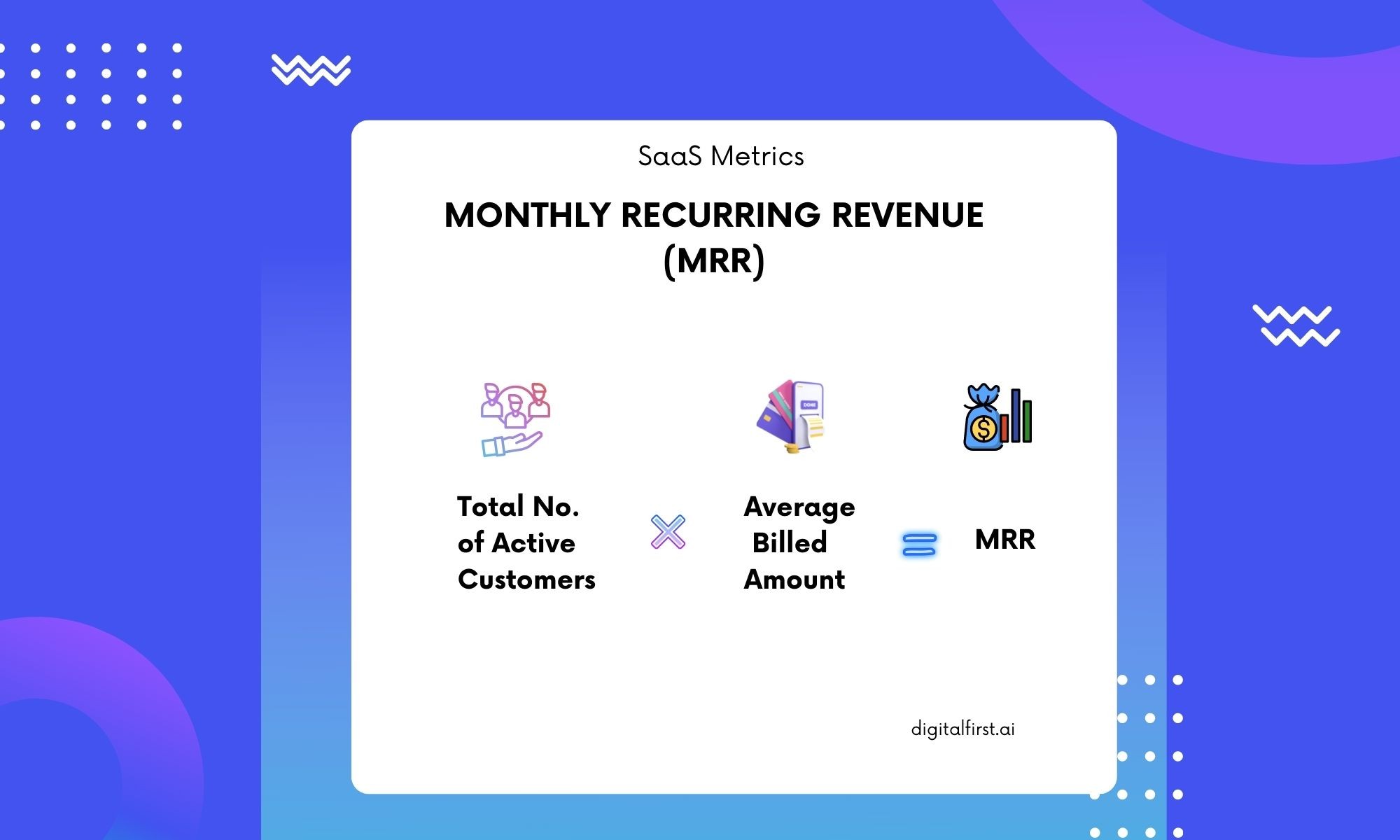
If you're new to SaaS, it might be hard to wrap your head around the concept of monthly recurring revenue (MRR).
MRR, or Monthly Recurring Revenue, is the amount of money you bring in each month from subscriptions and other recurring revenue. It’s a key metric for SaaS businesses and calculated by multiplying the number of customers by the average revenue per customer (ARPU).
Every month, you have a group of customers paying for your software. But some of them will cancel their subscriptions while other new ones sign up, which means the total amount your company brings in each month will fluctuate slightly. If you take all those numbers into account—purchases made over time plus cancellations—you can get a sense of what percentage of these “activated” accounts stick around long enough to generate future revenues (and thus contribute toward your monthly recurring income).
How to calculate MRR?
Monthly recurring revenue, or MRR, is a measure of how much recurring revenue your business is generating from subscription-based products and services. It's calculated by multiplying the number of new subscriptions in a month by their average monthly price.
For example, if you had 100 new customers in April who paid $30 per month for access to your product, your monthly recurring revenue would be $30 multiplied by 100 (the number of new signups) times 12 months (the duration of their subscription). This equals $3600 per year.
Pros and Cons of the MRR metric
The pros of using this metric are that it's very straightforward and easy to calculate—it's just the total amount of money your customers paid you divided by the number of months since they started paying you. So if one customer pays you $30 per month for three months, their MRR is $60/3 = $20.
The cons are that it doesn't take into account discounts or refunds; it only counts the actual dollars paid to you.
Annual Recurring Revenue (ARR)
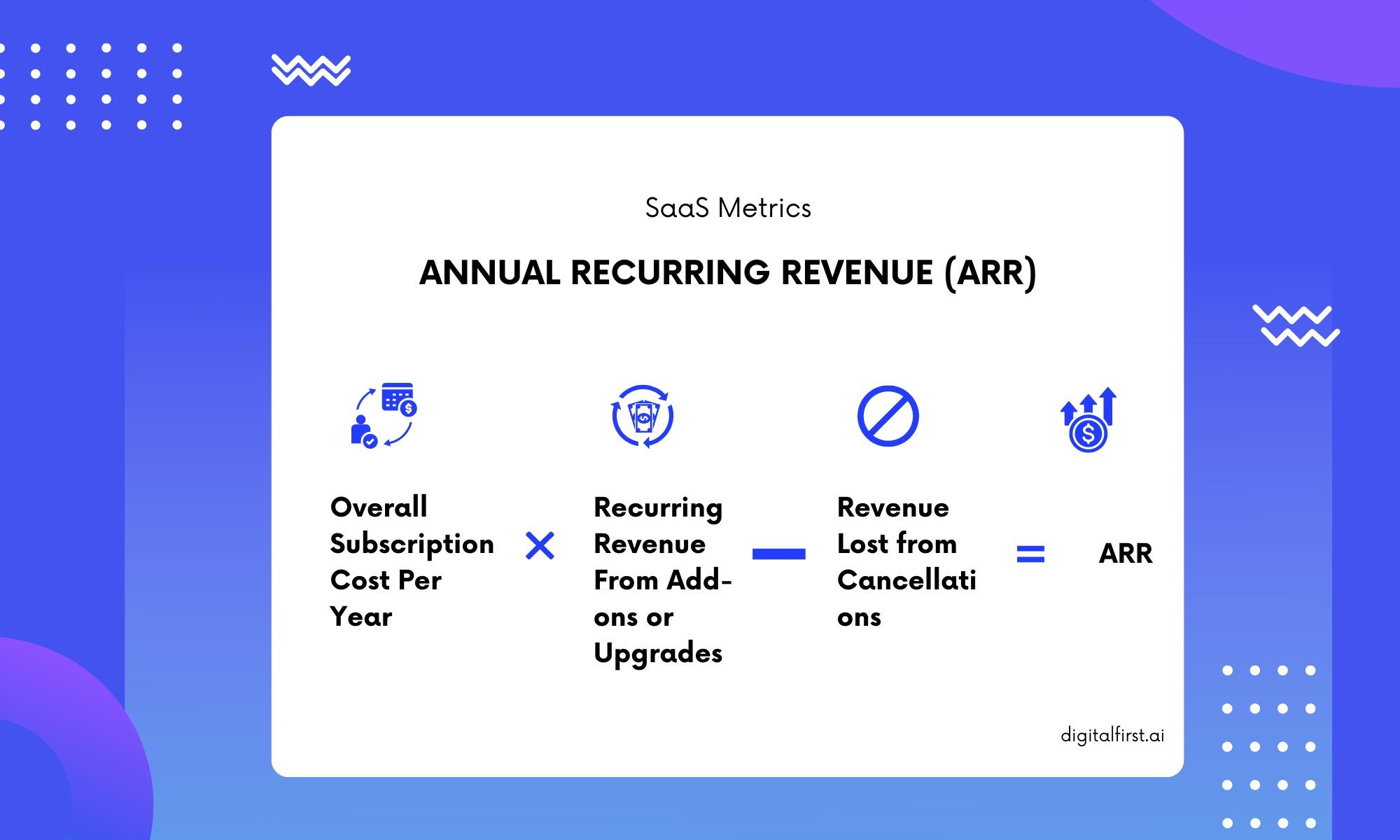
ARR stands for annual recurring revenue and is a metric used to measure the customer lifetime value (CLTV) of your SaaS business.
The acronym, however, is not a perfect representation of what this metric represents because it’s not actually revenue. What it actually measures is the total amount of money you expect to be paid by your customers each year over the course of their subscription period. It can also include renewals and automatic payments if they are part of your subscription model. In other words, it’s an estimate based on historical data and assumptions about how long customers will remain subscribed to your product or service after signing up initially (usually 12 months).
How to calculate ARR?
Here’s an example of how ARR can be used:
Your company offers two different products, A and B. You sell Product A monthly for $100 per month, and Product B quarterly for $600. You have 100 customers on Product A and 40 customers on Product B (so 150 total). The total amount of revenue from these customers equals $150000/year ($1200000 for Product A + 30000 for Product B)
To get your ARR, simply take the number of customers you have divided by 12 months in a year (120), then multiply that by their average subscription price (1200000), which gives us an ARR of 1 million dollars per year!
Pros and Cons of the ARR metric
In the context of SaaS, ARR is a good measure of your company’s health. It can tell you how likely it is that you will be able to generate revenue in the future and how much revenue you can expect to generate from these recurring fees. The main advantage of ARR is that it helps you understand if your business model is working or not. If your monthly recurring revenue (MRR) is growing, then this means customers are paying for additional services and/or increasing their usage over time. If MRR declines, then this could mean that customers are churning out at a faster rate than new ones coming in — which isn't sustainable in the long term!
Churn rate
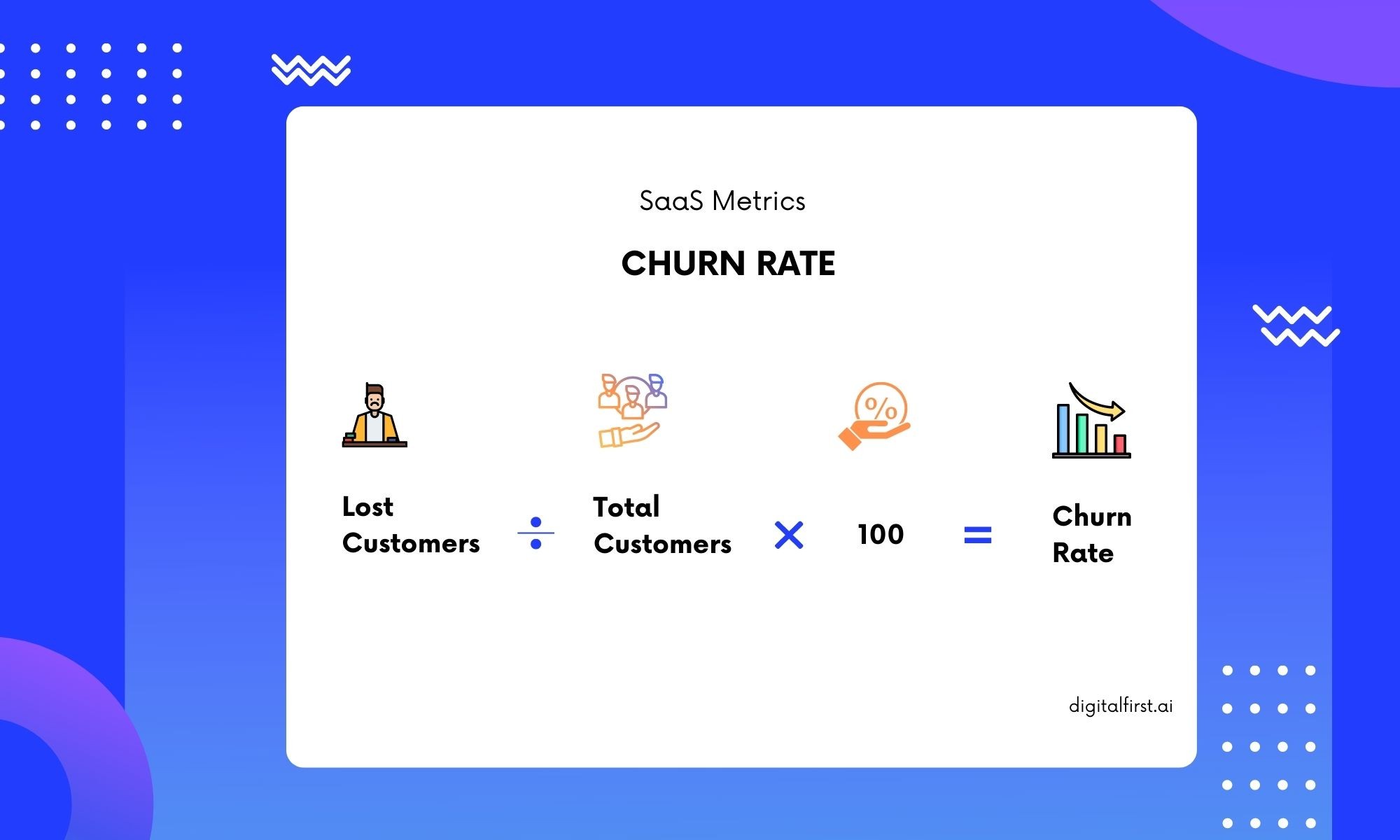
You might have heard of churn rate or customer churn before. It’s a metric that measures the number of customers who cancel their subscription to your SaaS product.
Churn rate is one of the most important metrics you can track, because it can show you how well your business is doing and help you identify issues with retention, satisfaction and more. First, let’s look at what types of information this metric provides:
Churn rate is a measure of customer satisfaction — if there are more people leaving than staying, this means that your service isn’t meeting their needs and they are less satisfied with it. This could also indicate that they simply don’t need what you offer anymore (or at all).
Churn rate can be used as an indicator for how well your product performs overall — if customers are leaving at higher rates than staying on board (or cancelling subscriptions), then something needs to change in order for things not only stay afloat but thrive as well!
The formula for churn rate is simple:
Churn Rate = (Number of Customers Lost) / (Total Number of Customers)
Why is it important to understand your churn rate?
Understanding how your churn rate is calculated and what it means will help you to:
Improve the customer experience
Identify your customers
Identify your most valuable customers
Identify your least valuable customers
How to calculate churn rate?
Churn rate is the rate at which customers stop subscribing to a service. It’s usually measured as a percentage, so if your churn rate is 20%, that means you’re losing 20% of your customers each year.
Churn rate is a measure of customer retention and one of the key performance indicators (KPIs) that businesses use to evaluate the health of their business. A high churn rate indicates that customers are unhappy with your products or services—or perhaps that there aren't enough benefits from using them—and they're leaving in droves.
Cohort analysis
You can use cohort analysis to identify cohorts and measure their performance over time. If a new feature or product release is not working, you might want to know which groups are responding better than others. Cohort analysis will help with that.
In cohort analysis, you group users based on when they first started using your app. For example:
The first group uses the app from January 1st through December 31st, but doesn’t come back after that period ends
The second group uses the app from February 1st through March 15th, and then decides not to continue after March 15th
Understanding Key Metrics for Retention
Retention metrics are an essential part of cohort analysis. They measure how long your customers are sticking around and can help you identify which user groups are most likely to churn.
Retention Rate: This metric measures the percentage of users who return to your product or service on a monthly basis within a specific time frame. The formula is (number of retained users) / (total number of users). For example, if you have 100 paying customers for your SaaS product, but only 50 come back after 30 days, then your retention rate would be 50%.
Churn Rate: This metric measures the percentage of people who stop using or purchasing your product or service in a given period of time; it’s calculated by dividing the total number of churned accounts by total accounts at the beginning of that period. For example, if there were 100 users when month 1 began and 25 left by month 2 without renewing their subscriptions or purchasing new ones, then your churn rate would be 25%.
How to Analyze Your Cohort Data Effectively?
Cohort analysis is a method of evaluating your customer retention based on the date of their first purchase. It’s similar to cohort marketing, which focuses on the group of customers who are reaching a certain point in time. This could be their birthday or another event that sparks an interest in your brand, product or service.
The purpose of this type of analysis is to understand how well you're retaining customers and if there are any trends that need improvement or adjustment. You can use it as a benchmark for future growth, identify opportunities for upselling and cross-selling products or services based on what worked best in previous campaigns, and set goals for new campaigns so they stay relevant throughout different seasons/holidays/etcetera.
The Benefits of Using a Cohort Analysis in SaaS
Cohort analysis allows you to track how your retention rate changes over time, which is a great way to see if the product is improving or not. You can also see how your retention rate changes between cohorts, so that if one cohort has a higher retention rate than another it's easy to find out why. For example, in this case let's say that the first cohort had 10% higher retention than the second cohort and we know what their marketing channels looked like at each stage. We can then use this information to improve on our future campaigns by adjusting spending or targeting specific groups of users who are likely to be retained into our product longer than others.
By using a cohort analysis, you can analyze your metrics more effectively to increase your retention rate.
It's a metric that SaaS companies use to measure customer loyalty.
It tells you the percentage of customers who renew their subscription.
It's an important metric because it reflects how happy your customers are with your product or service, and whether they feel compelled to continue using it. If you have a low retention rate, this will be reflected in your churn rate as well—which is the number of users who stop using your product after they've signed up for it.* This means that if you want to grow and scale your business (and who doesn't?), then improving customer retention is key.* This also ties into profitability since the more money a company makes from existing customers rather than having to spend money on attracting new ones, the better off it will be financially
Net Promoter Score (NPS)
The Net Promoter Score is a simple survey that measures customer loyalty. It's calculated by asking one question: "How likely are you to recommend this company/product/service to a friend or colleague?" Customers respond on a scale of 1-10, with 10 being the highest score and 1 being the lowest score.
The NPS provides an easy way to measure customer satisfaction as well as identify promoters, passives, and detractors.
NPS can help determine which customers are likely to purchase more products or services from your brand in the future, which ones could be turned into promoters through positive experiences with your brand (e.g., incentivizing purchasing), which ones might need special attention due to negative experiences with your brand (e.g., providing service recovery), and which ones should be avoided altogether for various reasons (e.g., dissatisfaction).
How to Calculate Net Promoter Score?
The NPS is a powerful metric that can help you understand how happy your customers are. It's also a great way to find out how likely they are to recommend your business.
The NPS is calculated by subtracting the percentage of detractors from the number of promoters. Dividing that score by the total number of respondents gives you the overall NPS for your business.
For example, if 5% of respondents describe themselves as detractors and 45% describe themselves as promoters, then:
D - P = (5% - 45%) / 50%, or P = 50%.
So in this example, an NPS of 50 would mean that half (50%) of people who took part in the survey were promoters and half were detractors — which means there was no clear majority either way.
NPS Question
The NPS question is: “How likely is it that you would recommend us to a friend or colleague?” The score itself is calculated by subtracting the percentage of people who answered 0-6 from the percentage of people who answered 9-10. In other words, if more customers reply with a 9 or 10 than those who reply with 0 through 6, your company will have a positive NPS score.
The beauty of this system is that it's easy for customers to understand (you can just ask them), and even easier for companies to calculate (you just subtract percentages). It also gives valuable insight into your company's performance—specifically its ability to exceed expectations and delight customers—in an easily digestible format.
2 Ways to Use the Net Promoter Score for Your Business
There are a number of ways that you can use the NPS to measure customer loyalty, satisfaction and experience. Here are a few:
Use the NPS to measure customer loyalty. For example, if your average score is around 50%, then it's likely that some customers are more loyal than others. You may want to dig deeper into what makes these people more loyal than others so that you can replicate their behavior in other areas of your business.
Use the NPS to understand customer satisfaction with different aspects of your business or products/services offered. For example, if one product has a higher score than another (e.g., 78% vs 66%), there may be an opportunity for improvement in this area of your business if there is a large discrepancy between scores here (or even just slightly lower scores). It could mean there’s room for improvement with marketing messaging or packaging design which could make all the difference!
3 Practical Tips for Increasing Your Net Promoter Score
Ask the right questions. The standard NPS question, “How likely are you to recommend [company] to a friend or colleague?” is not the only way for companies to gauge customer happiness. If you’re trying to improve satisfaction levels and have customers who aren’t promoters, try asking them what they would like improved as well as their feedback on specific products/services your company offers.
Use the right NPS question format. In addition to asking how likely someone is to recommend your company, it’s important to also ask why (or why not) they would do so—and what could be done differently in order for them not just say that they would recommend the experience but actually do so more often.
Use the right NPS question frequency. For those unfamiliar with NPS terminology: A promoter is someone who scores 9-10 on a 0-10 scale; an advocate scores 7-8; a passivescore 6-7; and a detractor scores 0-5.*
Customer Acquisition Cost (CAC)
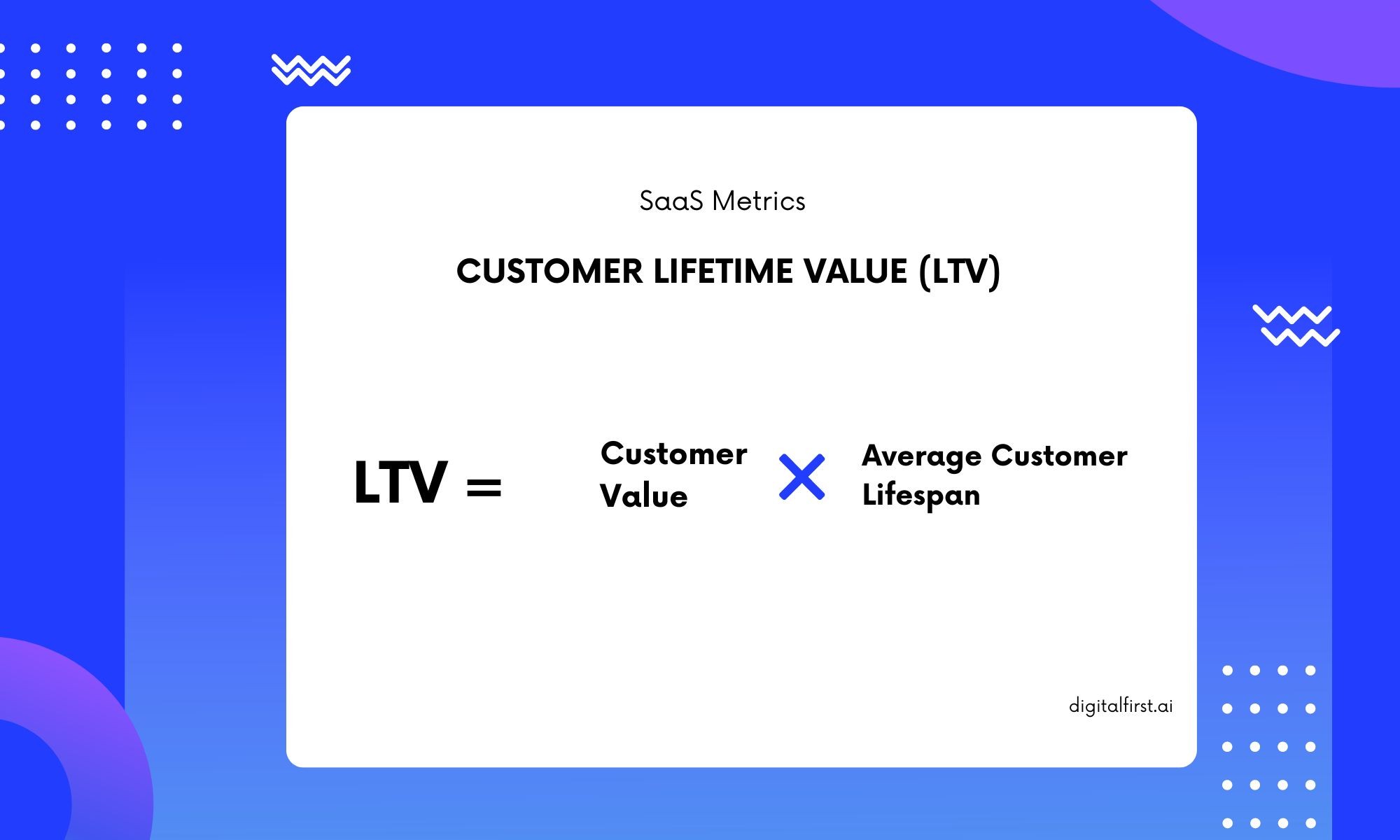
Customer acquisition cost (CAC) is the total cost of acquiring a new customer, including all marketing and sales expenses.
The average CAC for SaaS companies in 2017 was roughly $1,600.
This metric is important because it lets you know how much it costs your business to acquire each new customer or user. You can use this information to evaluate whether your current digital marketing funnel is effective and determine which channels are most and least profitable for your company’s growth.
Customer Lifetime Value (LTV)
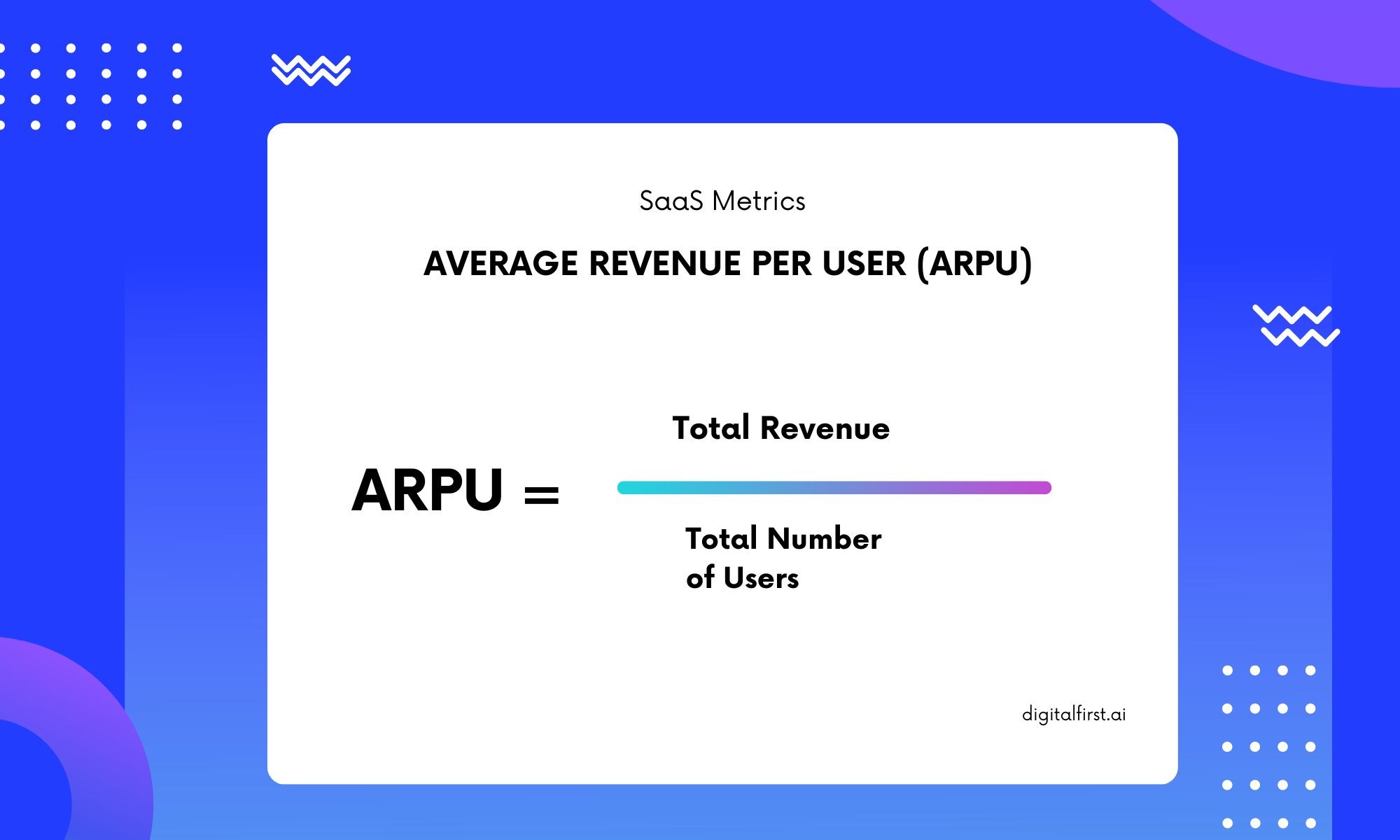
Customer Lifetime Value (LTV) is the total value of all future net profits attributable to a customer. This metric can be calculated by analyzing the average sales price, marginal cost and churn rate of your SaaS customers.
If you’re using this metric to decide whether or not to invest in a new customer, you should calculate their LTV and see if it’s worth investing more in them. If you have too many customers with high costs but low LTVs then that could indicate that your product or service isn't right for them so you may want to focus on other areas instead of trying harder with those customers who aren't interested in buying from you at this time.
Make sure that when calculating your LTV discount rate is taken into account as this will affect how much money is made per user: the higher their discount rate is relative to others then greater returns are likely going t
Average Revenue Per User (ARPU)
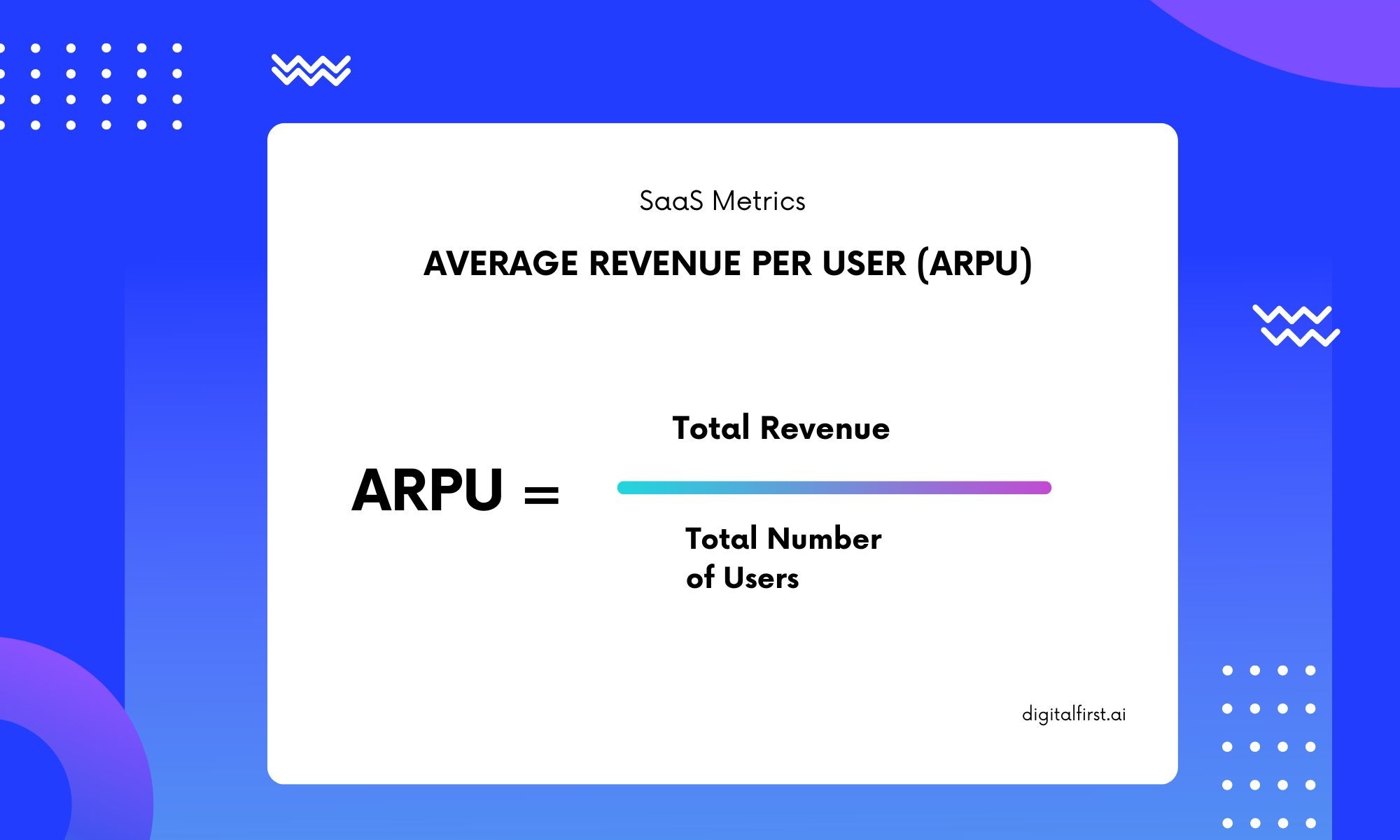
ARPU is a relatively simple metric to calculate, but one that can give you a lot of insight into the health of your SaaS business. It’s also one that’s used in a variety of different ways:
To measure the success of marketing campaigns. If you know how much money your users are making for you each month, it makes it easier to determine whether or not the cost per click for a given campaign is worth it.
To measure the success of sales campaigns. If an ad campaign drives more traffic than usual, but doesn't necessarily result in higher signups or MRR (monthly recurring revenue), then maybe it's time try something else!
As part of more complex calculations like LTV (lifetime value). When calculating any kind of annual value metric—such as LTV—you want to make sure you're maximizing all possible sources of revenue when doing so; this includes ARPU because it measures how much each user contributes on average over their lifetime with your company
Monthly Active Users (MAU)

Monthly Active Users (MAU) is a simple way of measuring how many customers are using your product on an ongoing basis. It combines the total number of users and unique user counts into one metric so that you can quickly get a sense for how much activity is happening within your software, which can be useful for prioritizing feature releases or bug fixes.
The formula for MAU is:
(number of users open your app in 30 days time frame)
Paying customers to free users ratio
The paying customers to free users ratio is a simple way of understanding how well you're converting your free users into paid ones.
What is it? The ratio is the number of paying customers divided by the number of free trial signups in any given time period. For example, if you have 100 paying customers and 25 people signed up for a free trial during the last month, then your ratio would be 4:1.
Where does this metric come from? This metric measures conversion rates from one metric to another (i.e., sessions per user). It's not specific enough on its own but can be used with other metrics like retention rate and customer lifetime value (CLV) per customer to build a complete picture about how well your business is performing financially.
How can you use this metric? You'll want to track this on an ongoing basis so that you can see if there are any major changes between periods or seasons — even over longer stretches — which may indicate something has changed with either how many people sign up or how likely they are to convert into paying customers after their trial ends.*
Do referrals convert well?
If you’re not tracking referrals, then you don't know the answer. A customer who refers someone is a happy and loyal customer who feels like they've done something valuable for you and as a result, they will likely remain with your brand longer.
Not only do these customers refer others, but they also make better salespeople because they are passionate about what they've bought from your company and want to share that with others. The more referrals a person makes, the more successful those referrals will be for both parties involved—the person being referred and yourself! The key is to get as many people as possible referring other potential customers to you so that everyone can benefit from this mutually beneficial relationship.
The first step in creating an effective referral program is identifying which metrics matter most for measuring success (or lack thereof). This will help ensure that all aspects of the program are working efficiently together in order to achieve maximum results based on its goals/objectives .
Some common reasons why companies fail at referral programs include: insufficient budgeting; unclear communication between departments; not having enough employees throughout an entire organization dedicated solely towards making sure that these relationships continue growing stronger over time (rather than just being left unattended); no incentive structure within place - meaning there are no rewards given out periodically so people feel incentivized enough incentive when promoting their friends' products/services instead!
What sources of traffic drive the most leads?
You need to know how many new leads your marketing efforts are generating.
Your main source of new leads will typically be from one of these channels:
Referral sources (e.g., by word-of-mouth)
Search engine optimization (SEO) and pay-per-click advertising (PPC). Many B2B companies also get a lot of business from organic search results, so it can't be ignored in this equation!
Social media — especially LinkedIn. This is one place where many companies fail miserably, so do not make the same mistake! If you’re not using LinkedIn for lead generation, start now! In fact, I'd go so far as to say that if you don't understand what social media platforms are right for your business and why they're important, then you probably don't have any marketing strategy at all!
What referral sources convert best?
The best referral sources are the ones that convert more than any other and are relevant to your business. If you're selling a service for small businesses that helps them automate their marketing, referrals from sites like Yelp and LinkedIn will be more valuable than referrals from Facebook or Twitter. These types of sites send customers who have already expressed some interest in what you do—so they're likely more ready to buy now than someone coming from an ad on Facebook.
But it's not just about how many people come through your top of the funnel. it's also important to look at which channels drive users who eventually become paying customers (known as "conversion rates"). For example, if referrals from LinkedIn result in one out of every 100 visitors becoming a paying customer while referrals from Facebook result in one out of every 1,000 visitors becoming a paying customer, then LinkedIn is the better option because its conversion rate is higher even though it doesn't generate as many clicks overall.
What marketing channel brings in the most revenue?
One of the best ways to increase revenue is by using a variety of marketing channels.
Marketing channels are how you reach your target audience. They can include:
Referral programs
SEO (search engine optimization)
Social media advertising
The metrics you should be focused on when evaluating marketing channels are:
Revenue per lead generated. This tells you how many sales were made by each lead, or person who visited your website and had contact with one of your employees—but didn't necessarily buy anything right away. To calculate this metric, divide total number of leads by total revenue from those leads over some period of time (e.g., last month). The result will tell you whether each lead converted into a sale at an acceptable rate for you as a business owner or manager to keep pursuing these same types of prospects in the future—or if there's an issue that needs addressing before continuing down this path until something changes for better results!
Build Marketing Workflows That Work for you

No credit card needed. Instant access. Try now for free
Digital First AI empowers marketers with AI-driven tools to centralize data, build personalized strategies, and execute campaigns seamlessly.
Generate content, automate workflows, and outpace competitors—all in one secure platform.
AI-Powered Data Room: Centralize and analyze unstructured data for actionable insights.
AI Strategy Canvases: Generate 26+ strategic canvases for tailored campaigns.
Advanced Research Tools: Conduct real-time market and competitor research.
AI Content & Visuals: Create high-quality copy and visuals with leading AI models.
Drag-and-Drop Workflow Builder: Design and automate custom workflows effortlessly.
Pre-Built Templates: Jumpstart campaigns with customizable templates.
Over 15,000 marketers and entrepreneurs from around the world are already reaping the benefits. Enjoy a free trial without any commitments!
It's wrap
Hopefully this article has inspired you to dive into your SaaS metrics and start analyzing them. Analytics are an important part of any business, but they're especially crucial in SaaS because ultimately, it's all about the money. By understanding which metrics matter most to your business and how they affect your bottom line, you can make better decisions about where to focus your time and energy when it comes time for a new marketing campaign or product launch.




